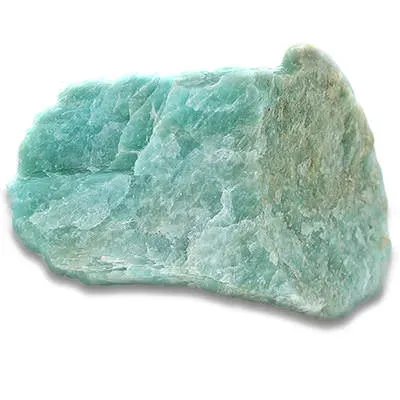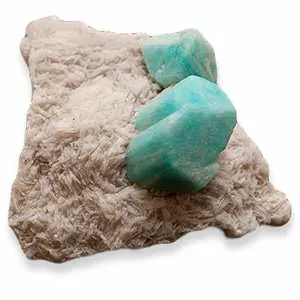 The ancient Egyptians, who made beautiful jewelry and ornamental pieces from this stone, made amazonite famous. The folk name for amazonite is 'the Amazon stone'. It was called this in the belief that the stone came from the Amazon River. However, this is not really the case. The stone was named after the Amazon river, but it was never actually found near the river. It was and is however, mined in other places around Brazil. Amazonite is a semi opaque blue-green variety of microcline, a form of alkali feldspar. The name 'microcline' comes from the Greek words micros, meaning 'small', and klino, meaning 'lean', because the cleavage planes in the stone deviate slightly from 90 degrees.
The ancient Egyptians, who made beautiful jewelry and ornamental pieces from this stone, made amazonite famous. The folk name for amazonite is 'the Amazon stone'. It was called this in the belief that the stone came from the Amazon River. However, this is not really the case. The stone was named after the Amazon river, but it was never actually found near the river. It was and is however, mined in other places around Brazil. Amazonite is a semi opaque blue-green variety of microcline, a form of alkali feldspar. The name 'microcline' comes from the Greek words micros, meaning 'small', and klino, meaning 'lean', because the cleavage planes in the stone deviate slightly from 90 degrees.
 The value of amazonite is quite low, but beautifully fashioned or antique pieces can be quite valuable. Amazonite is not produced synthetically but was occasionally imitated in the past using necklace beads that were actually made of a special type of glass. Amazonite can form the largest known crystals of any mineral. These large stones are often on the market. Amazonite ranges in color from colorless, to white, yellow, bluish, pink, red, gray, or many different shades of green, from pale-green to bluish aqua-green. Sometimes, the color of Amazonite is referred to as apple green however its actual color is never quite as bright as a green apple. The color of amazonite is due to the presence of lead within the stone and color variation may exist within a single stone. It is frequently veined with white or yellow bands of plagioclase. Amazonite has been known to be confused with
The value of amazonite is quite low, but beautifully fashioned or antique pieces can be quite valuable. Amazonite is not produced synthetically but was occasionally imitated in the past using necklace beads that were actually made of a special type of glass. Amazonite can form the largest known crystals of any mineral. These large stones are often on the market. Amazonite ranges in color from colorless, to white, yellow, bluish, pink, red, gray, or many different shades of green, from pale-green to bluish aqua-green. Sometimes, the color of Amazonite is referred to as apple green however its actual color is never quite as bright as a green apple. The color of amazonite is due to the presence of lead within the stone and color variation may exist within a single stone. It is frequently veined with white or yellow bands of plagioclase. Amazonite has been known to be confused with ![]() turquoise and
turquoise and ![]() jade. Especially when it is opaque, amazonite tends to be misnamed and not identified correctly.
jade. Especially when it is opaque, amazonite tends to be misnamed and not identified correctly.
 Amazonite rates a 6 to 6.5 on the hardness scale. It is brittle, and translucent to opaque, with a vitreous to silky luster and easy cleavage. Most specimens are opaque, so translucent crystals are more valuable. Amazonite is usually cut into cabochons for necklaces and pendants, or used to carve figurines or other ornamental items. Amazonite is found in hydrothermal veins, pegmatites, granite pegmatites, schists and gneisses, and also as grains in sedimentary rocks. It is formed in deep-sea igneous rocks that once cooled very slowly. The most important source of amazonite is India. Especially fine specimens are also found in Colorado. Other sources for Amazonite include various areas around Madagascar, Namibia, Brazil, Zimbabwe, Canada, India, Tanzania, Australia and the Soviet Union. Amazonite can also be found in the United States, mostly near Pike's Peak, Colorado, and also in Maine.
Amazonite rates a 6 to 6.5 on the hardness scale. It is brittle, and translucent to opaque, with a vitreous to silky luster and easy cleavage. Most specimens are opaque, so translucent crystals are more valuable. Amazonite is usually cut into cabochons for necklaces and pendants, or used to carve figurines or other ornamental items. Amazonite is found in hydrothermal veins, pegmatites, granite pegmatites, schists and gneisses, and also as grains in sedimentary rocks. It is formed in deep-sea igneous rocks that once cooled very slowly. The most important source of amazonite is India. Especially fine specimens are also found in Colorado. Other sources for Amazonite include various areas around Madagascar, Namibia, Brazil, Zimbabwe, Canada, India, Tanzania, Australia and the Soviet Union. Amazonite can also be found in the United States, mostly near Pike's Peak, Colorado, and also in Maine.
 Like
Like ![]() jade, amazonite is associated with luck, money, and overall success. In fact, wearing amazonite is actually recommended for gamblers. Amazonite is very valuable for artists as it releases the wearer's emotional grief by expressing it creatively. As a result, it is beneficial for writers, musicians, dancers, and other artists. As it creates success, it helps artists concentrate, and follow through their projects to completion. The stone also helps the wearer boost self-confidence and self-validation. Medically, amazonite is said to help problems with the thyroid glands. It also aids in treating alcoholism. Amazonite is used to treat fatigue, trauma, or anything else that may take energy away from a person. It has a gentle healing quality that is useful to nearly everyone in a general manner.
jade, amazonite is associated with luck, money, and overall success. In fact, wearing amazonite is actually recommended for gamblers. Amazonite is very valuable for artists as it releases the wearer's emotional grief by expressing it creatively. As a result, it is beneficial for writers, musicians, dancers, and other artists. As it creates success, it helps artists concentrate, and follow through their projects to completion. The stone also helps the wearer boost self-confidence and self-validation. Medically, amazonite is said to help problems with the thyroid glands. It also aids in treating alcoholism. Amazonite is used to treat fatigue, trauma, or anything else that may take energy away from a person. It has a gentle healing quality that is useful to nearly everyone in a general manner.